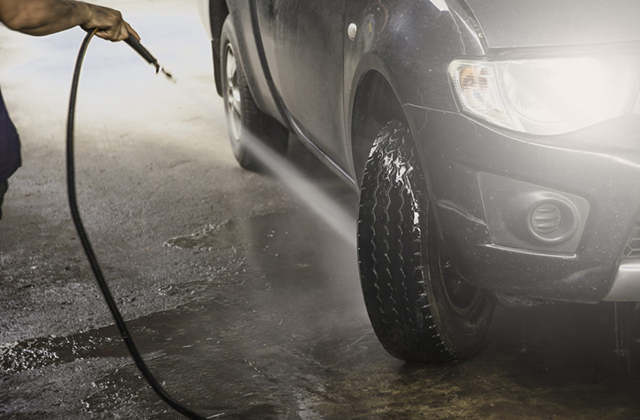Look no further wheel woolies brushes are safest and most thorough cleaning for your wheels. Upholstery grade leather has about 25% moisture content as it leaves the tannery. This moisture content is typically natural oils like neetsfoot that is infused into the fiber structure imparting suppleness. These oils are volatile, meaning they evaporate away overtime at a rate dependent on heat and humidity. If you are in a very dry climate and the leather is exposed to direct sun or other heat source then the evaporation rate is considerably accelerated compared to a damp climate or where the leather is not exposed to a direct heat source like the warming sun. Car leather care is a topic that is filled with bad information and bad opinions.
As moisture evaporates from leather two things happen: 1. the leather shrinks due to lose of mass, and 2. the leather loses is internal lubrication. In either case the effect is stiffening. At some point, where the moisture content drops below 5% or so, the leather feels and behaves like a piece of cardboard. This is its demise.
Leather conditioners contain replenishing oils. The goal of conditioning leather then is instill lost lubrication to keep the moisture content elevated. Consequently, this simple maintenance procedure prolongs the leather’s life. It’s a pretty simple concept. However, there is more to the story. Here are some important considerations:
pH Issue. pH measures acidity or alkalinity. The range is from 1 to 14 with pure water being neutral at 7.0. Leather is acidic. It measures 4.5 to 5.0 on a pH scale. Furthermore, the pH scale is logarithmic, meaning that each whole number is 10 times more or less acidic or alkaline than the next number in the scale. When you mix two elements that have differing pH, a chemical reaction occurs. In the case of leather, this chemical reaction accelerates the breakdown of leather fibers. Therefore, any conditioner applied to leather should be pH balanced to leather so as not to damage the leather.
Coated (Pigmented) Leather. Most leather has a surface color coating. This coating is also covered with a clear coat providing protection and wear resistance. So, if something spills on the leather, it is easily wiped up without penetrating and staining the leather. These coatings are generally chemical engineered to have a certain degree of porosity, allowing the leather to breath. However, the ability for a conditioning agent to penetrate through this protective barrier is a challenge. This is particularly true with automobile grade leather. For automobile leather, the most effective procedure is to warm the leather up a bit (leave the car in the sun for a few hours) before you apply a conditioner. Warming the leather reduces viscosity allowing a higher absorption potential. Then, aggressively massaging the conditioner into the leather will help.
Over conditioning. If a little is good, then a lot must be better, right? A common mistake is to apply too much conditioner. Think of a sponge fully laden with water. Adding more water is not possible. This is also true with leather. If the moisture content is at its maximum, then adding more conditioner does nothing except to sit on the leather surface, drying over time and turning sticky and gooey.
Old, Desiccated Leather. If old leather has lost most of its moisture then it can be a huge mistake to attempt to revive it by adding conditioner (moisture). Think of a piece of cardboard that gets wet. It turns the cardboard fibers to mush. The same is true for leather. If your leather is old and dried out, the best strategy is to leave it alone and consult a professional. There are specific chemistries that can be used to prolong the life of old leather. The run-of-the-mill conditioner is not one of them.
When to Condition. As in over conditioning, if the leather is new, then it has a full compliment of moisture. There is no reason to condition as it hasn’t had time to lose its moisture. As a general rule, begin conditioning leather after 6 months to a year. And then re-apply every 3 to 6 months depending how dry the environment. In certain cases a more frequent regimen is appropriate like in the summer months of a desert climate.
What to buy? There are dozens of leather conditioning products on the market so it can be confusing. Read the label.
If it says for leather or vinyl, it’s not right as you can’t have an effect product that works for both materials. They are very different from each other. One is organic, the other synthetic.
See if it’s pH balanced to leather. If it doesn’t say it, conclude that it is not good for your leather. This pH issue is the single most important consideration. And, it is the reason why you should NEVER use saddle soap for furniture or automotive grade leather. It’s far to harsh.
What does it smell like? Its going into your car or home. You’ll have to live with the odor if it’s not pleasant.
Talk to a pro. Get advice from those in the know. And, that’s probably not the sales clerk selling it.
How to Apply. Generally, a thin coating is sufficient. Apply the conditioner to a soft cloth, massaging into the cloth and then wipe over the target leather. If the leather is heavily coated, then massage the leather with the conditioner.
Leather That Should Not Be Conditioned. Be very careful with suede or nubuck leather. While they will lose moisture as well, conditioning them in a standard procedure runs to risk of staining the leather. It can leave the leather looking blotchy, thus destroying the aesthetic appeal. Additionally, delicate leather like calf or lamb skin should be treated cautiously.
The most important consideration is to be sure that you are doing the right thing with whatever maintenance products you use on leather. In the end it’s always wise to consult with a professional.
To learn more visit http://www.advleather.com. They have excellent cleaning and conditioning products. For example SG – 25 is pH balanced to leather so it perfect for leather. Get in touch with our guy for leather cleaner.
Article Source: http://EzineArticles.com/expert/Kevin_Gillan/49290
Article Source: http://EzineArticles.com/9758721

